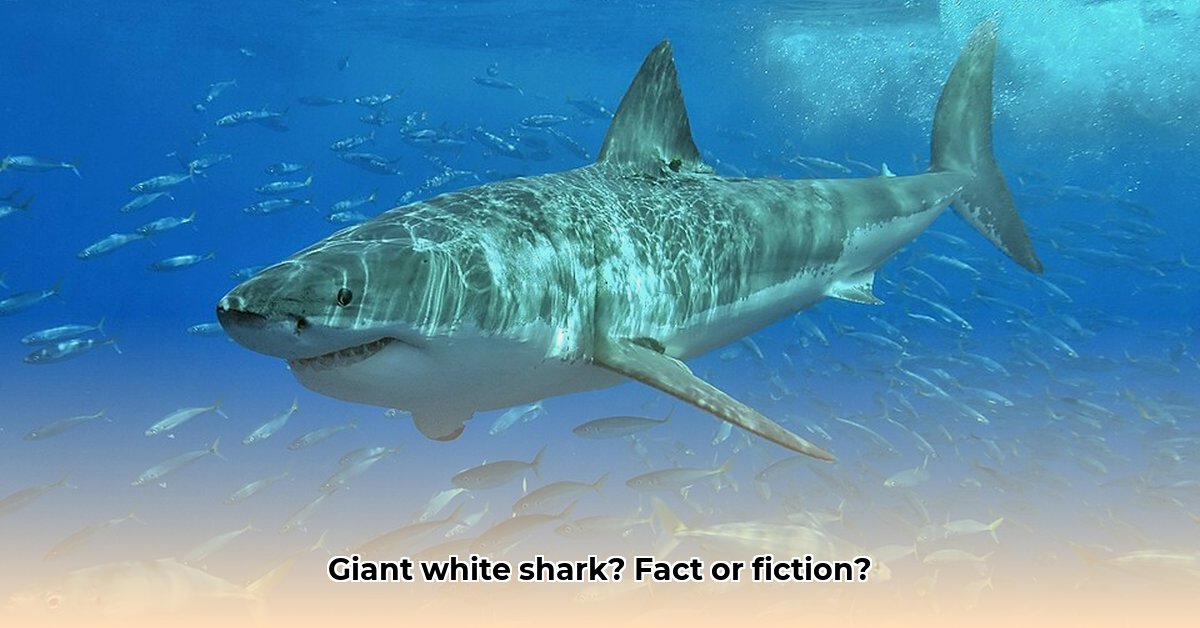Ever heard tales of enormous great white sharks, the kind that make Jaws look like a goldfish? Stories of massive, 30-foot-long beasts have swirled for years. But how much of that is real, and how much is just tall tales? This article separates fact from fiction, looking at the biggest great whites ever actually measured. We’ll examine the best evidence, investigate how scientists figure out their size (it’s trickier than you might think!), and discuss the legendary sharks like Deep Blue. Get ready to dive in and discover the truth about these ocean giants!
Biggest White Shark Size: Separating Fact from Myth
Unraveling the mysteries of the ocean’s largest predators, great white sharks, is a fascinating journey. Ever wondered just how big these magnificent creatures can get? The short answer is: it’s complicated! While seafaring legends speak of monstrous great whites that could swallow a small boat whole, the truth, backed by science, is a bit more nuanced—and still full of exciting discoveries, revealing the real great white shark size.
Measuring the Immeasurable: Historical Shark Measurement Methods vs. Modern Tech
Early attempts to measure the size of great white sharks were, to put it mildly, less than precise. Imagine trying to measure a decomposing carcass—a task that’s both difficult and prone to significant error. Early reports relied heavily on eyewitness accounts, often amplified by fear and a healthy dose of exaggeration. Furthermore, photos weren’t always helpful; a clever camera angle could make a 15-foot shark seem like a 25-footer. Adding to the confusion, sometimes a basking shark, a completely different species, was mistaken for a great white. Distinguishing between the two in a blurry picture is as hard as finding your keys in a dark room!
Thankfully, things have improved dramatically. Modern scientists now utilize incredibly precise, non-invasive techniques like laser photogrammetry (using lasers to create 3D models) and advanced stereo-video analysis. These methods produce 3D models, allowing researchers to get incredibly detailed measurements without harming the sharks. Think of it as getting a really accurate 3D scan, only instead of scanning a human, you’re scanning a majestic great white. This technological leap has allowed us to separate fact from fantasy in figuring out exactly how big these amazing animals truly grow. Did you know that advanced stereo-video analysis helps provide detailed measurements without harming sharks?
Deep Blue: Understanding Great White Shark Maximum Size
Deep Blue, a female great white, takes center stage in the “biggest great white” saga. First spotted near Guadalupe Island, Mexico, this colossal shark is estimated to be around 20 feet (6 meters) long and is believed to be over 50 years old. While estimates place her size around 20 feet (6 meters), remember, the measurements are still estimates, not exact numbers. What makes Deep Blue especially interesting is that she is the biggest great white shark ever filmed. Her story highlights the challenges of accurately measuring such immense creatures in their natural environment.
This extraordinary size is still impressive but illustrates that even the largest confirmed great white falls far short of many exaggerated claims. Deep Blue’s fame isn’t just about her size; she captures the human imagination, highlighting the immense power and mystery of these ocean giants.
Revisiting the Past: Overestimated Shark Sizes and Early Measurement Errors
Several historical reports described great white sharks exceeding 30 feet, and a few even approached 40 feet in length – the Cojimar shark (caught off Cuba in 1945) and reports from the 1870s in Australia. However, re-examinations using modern techniques have shown these initial claims to be significantly overestimated. For example, the Cojimar specimen, initially reported at 21 feet, was later estimated to be closer to 16 feet after analysis of photographs. This doesn’t mean those sharks weren’t big; it means our early methods of measuring them were unreliable. Often, re-evaluating older measurements reveals significant errors. This fact highlights the importance of careful methodology and continuous improvement in scientific practices. How reliable are historical great white shark size records, considering the measurement methods used at the time?
So, How Big Is the Biggest Great White? Great White Shark Size Demystified
The current scientific consensus suggests that the average adult great white shark measures between 14 and 16 feet (4.3-4.9 meters). Females typically grow larger than males. While some individuals undoubtedly exceed 20 feet, it’s crucial to remember that only verified measurements count. The quest to pinpoint the absolute largest great white ever recorded is ongoing; we’re still learning! This uncertainty shouldn’t diminish the awe inspired by these magnificent animals; it only adds to the adventure of discovery.
The Future of Great White Research: Standardized Measurement Protocols
The adventure of learning more about great white sharks is far from over. Scientists are working hard to establish standardized measurement protocols. This means developing clear, consistent guidelines so every researcher uses the same methods. The result? More accurate and comparable data. Furthermore, continuous use of cutting-edge technology will provide even more precise data on these magnificent creatures. This will help us understand their growth patterns, what influences their size, and more. Imagine the possibilities!
Comparing Shark Measurement Methods Old and New
| Technique | How it Works | Advantages | Disadvantages | Accuracy |
|---|---|---|---|---|
| Carcass Measurement | Measuring the dead shark | Simple, data available (but only after the shark dies!) | Inaccurate due to decay and deterioration; only possible after death | Very Low |
| Photography | Taking pictures of the shark | Non-invasive; relatively easy | Highly susceptible to perspective and distortion; unreliable sizing | Low |
| Laser Photogrammetry | Using lasers to create a 3D model of the shark | Highly precise; non-invasive | Requires specialized equipment and training | High |
| Stereo-Video Analysis | Using multiple cameras to create a 3D model of the shark | Highly precise; allows for detailed measurements in 3D; non-invasive | Requires specialized equipment and training | High |
The ongoing search for the biggest great white shark is a testament to our fascination with nature’s wonders. Combining careful observation, advanced technology, and rigorous scientific processes is gradually uncovering the truth about these remarkable animals, replacing speculation and myth with evidence-based understanding. The story of the great white continues, and the next chapter could just write itself! Great White Shark Size Measurement Techniques: A Historical Overview and Modern Advancements
How to Accurately Measure Great White Shark: Modern Shark Science
Key Takeaways:
- Multiple methods exist for estimating great white shark size, each with varying accuracy, highlighting great white shark scientific measurement.
- Direct measurement is the gold standard but often impractical. Indirect methods, such as using tooth measurements, are valuable alternatives.
- Tooth size (interdental distance and crown height) correlates with total length, but accuracy depends on factors like tooth completeness and species-specific growth patterns.
- Standardized measurement protocols are crucial for reliable data comparisons and effective conservation.
- Advanced statistical techniques can improve estimation accuracy but require comprehensive datasets.
The Challenges of Measuring a Giant: Understanding the Challenges
Measuring a great white shark isn’t as simple as grabbing a tape measure. These animals are powerful and elusive. How do we accurately determine the size of the biggest great white shark ever recorded? It’s a question that’s plagued researchers for years. Early methods were often imprecise, leading to inconsistencies in reported sizes. But modern techniques are improving our understanding.
Direct Measurement: The Ideal, But Impractical Shark Measurement Technique
Ideally, we’d measure a great white shark directly, using laser rangefinders or specialized measuring tapes while the shark remains safely in the water or after a controlled capture and release. This provides the most accurate total length (TL) measurements. However, measuring a live, enormous, potentially dangerous shark is incredibly difficult and presents logistical challenges. Furthermore, direct measurements are impossible for deceased or stranded specimens.
Indirect Estimation: Tooth Metrics and Their Role in Shark Research
When direct measurement isn’t an option, scientists rely on indirect methods. One common approach involves analyzing the shark’s teeth. Studies have shown a strong correlation between tooth size (specifically, interdental distance and crown height) and the shark’s total length.
How it Works:
- Obtain a tooth sample: This may come from a stranded shark, a bite mark, or even a naturally shed tooth.
- Precise measurements: Carefully measure the interdental distance (the space between teeth) and the crown height (the visible portion of the tooth). Digital calipers ensure accuracy.
- Apply a formula: Using species-specific formulas derived from previous studies correlating tooth size and total length, scientists can estimate a shark’s overall size. The formulas vary depending on the species and the specific tooth being measured. These formulas rely on large datasets of previously measured sharks where both tooth and total length data exists.
The Importance of Standardization in Shark Measurement
The accuracy of any estimation hinges on standardization. Different researchers may employ slightly different methods, leading to discrepancies. Consistent protocols are needed for reliable comparison across studies and to build comprehensive databases of shark sizes and population data. This will improve the accuracy of future estimations. Did you know that reliable data comparisons help researchers better understand shark sizes?
Limitations and Ongoing Shark Research
While tooth-based estimation is a
- Master Parts of Pants:Perfect Fit Guide - June 14, 2025
- Unlock Your Vinyl: Parts of a Record Player Guide - June 14, 2025
- Shop Authentic Southwestern Clothing: A Guide - June 14, 2025
















